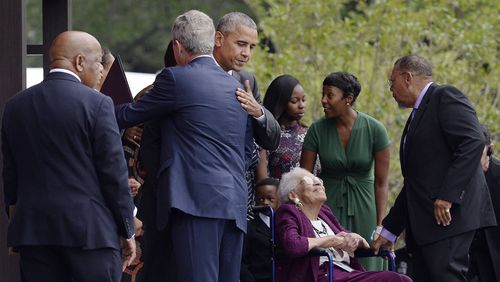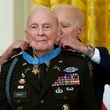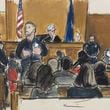On the heels of a tense and bloody week that brought racial inequality roaring to the national forefront once again, President Barack Obama on Saturday called on the country to reflect on its checkered past while celebrating the contributions of African-Americans.
The occasion, the grand opening of the National Museum of African American History and Culture, drew a bevy of politicians, celebrities and thousands of spectators to the National Mall as Obama, the nation’s first black president, formally opened the doors to the Smithsonian Institution’s 19th museum.
The event was a joyous one, one that marked the end of a century-long quest to open a national museum celebrating African-American achievements.
But the troublesome headlines of the week — and the summer more broadly — were clearly not far from the minds of speakers and performers alike. Weaved in throughout the program were nods to the recent unrest in Tulsa, Okla., and Charlotte, N.C., in addition to yesterday’s horrors of slavery and Jim Crow.
“African-American history is not somehow separate than the American story,” Obama said. “It is not the underside of the American story. It is central to the American story.”
A unifying chord throughout many of Saturday’s speeches was the notion that despite how far the United States has come in terms of its treatment of African-Americans, the journey to full equality and reconciliation is still far from complete.
The museum “shows our commitment to truth,” said former President George W. Bush, who gave a short speech at the event. “A great nation does not hide its truth, but faces its flaws and corrects them.”
‘Heart to heart, breath to breath’
Thousands of people crowded around giant television screens on the grounds of the Washington Monument to view the proceedings, which included performances by Stevie Wonder and Patti LaBelle.
Hollywood heavyweights Will Smith, Angela Bassett and Oprah Winfrey also gave short speeches on the front steps of the 400,000-square-foot museum, which is cased in distinctive bronze-colored ironwork meant to emulate the work of New Orleans slaves.
Much of the exhibit space on the 5-acre site is underground, housed in winding halls that tell the story of African-Americans from the trans-Atlantic slave trade through Obama’s election. Upper floors of the museum focus on contributions to music, the arts and sports.
Crown jewels among the museum’s nearly 40,000-item collection include the casket of Emmett Till and a segregation-era railway car that serviced routes in Georgia. It also includes exhibits on civil rights heroes from the state, including the Rev. Martin Luther King Jr. and U.S. Rep. John Lewis, who trumpeted the museum’s cause on Capitol Hill beginning in 1988 during his first term in Congress.
Lewis on Saturday was one of the biggest honorees of the day, sitting behind the Obamas and Bushes on stage.
The 76-year-old Atlanta Democrat was greeted with a standing ovation from the crowd when he took to the podium for a powerful 6-minute speech during which he jubilantly exclaimed: “As long as there is a United States of America, now there will be a National Museum of African American History and Culture.”
Lewis alluded to the museum’s roots in 1916, when a group of African-American Civil War veterans first raised the idea of a national monument honoring black soldiers in the nation’s capital.
“If you could roll up the sleeves of those veterans or touch the rubble on their backs, you might find the wounds of shackles and whips,” Lewis said. “They understood the meaning of their contribution, they set a possibility in motion — passed them down through the ages from heart to heart and breath to breath — that we are giving birth to today.”
Lewis, who earlier this summer said he worried the country was backsliding in terms of race relations, said in a recent interview that he hopes the museum will help the country heal many of its racial wounds.
“I truly believe that this museum can be helpful in moving us closer to a period of healing and maybe toward bringing the American community together, where we can lay down the burden of race,” Lewis said.
For whom the bell tolls
Many Georgians were on hand to cheer on Lewis and participate in the weekend's festivities, which included a private concert at the Kennedy Center, a Friday soiree at the White House and a reception hosted by Morehouse College's alumni association in Washington's mammoth convention center.
One of those Georgians was Patricia Damron Malone, a retired educator who took a bus from Fairburn to Washington to attend the opening with her husband.
“It was what I expected,” she said. “Obama always has the right comments, and he says what needs to be said about the past, present and future.”
Obama’s speech, which at several points referenced Langston Hughes’ famous poem “I, Too,” was bookended by powerful imagery aimed at summing up the museum’s role as an educational tool.
He discussed a large stone on display at the museum once used as a block in the auctioning of black slaves. For a long time, Obama said, the sole plaque on the stone was one marking the white politicians who had once spoken there. References to the countless slaves whose lives were ripped apart there were omitted.
“That same object reframed, put in context, tells us so much more,” he said. “As Americas, we rightfully pass on the tales of the giants. … But too often we ignored or forgot the stories of millions upon millions of others who built this nation.”
The president ended his speech ringing a bell borrowed from the historic First Baptist Church in Williamsburg, Va., with 99-year-old Ruth Bonner, the daughter of Elijah Odom, a man born a slave in Mississippi. After the bell tolled, the crowd stood silent. Several beats later, bells from churches across the city rang in unison, acknowledging how far the country’s come and the long road ahead.
How John Lewis’ perseverance helped produce the Smithsonian’s African-American museum
Here’s what you need to know about visiting the museum this weekend
Morehouse another Atlanta link to new Smithsonian black museum








